Backgammon Game Basics
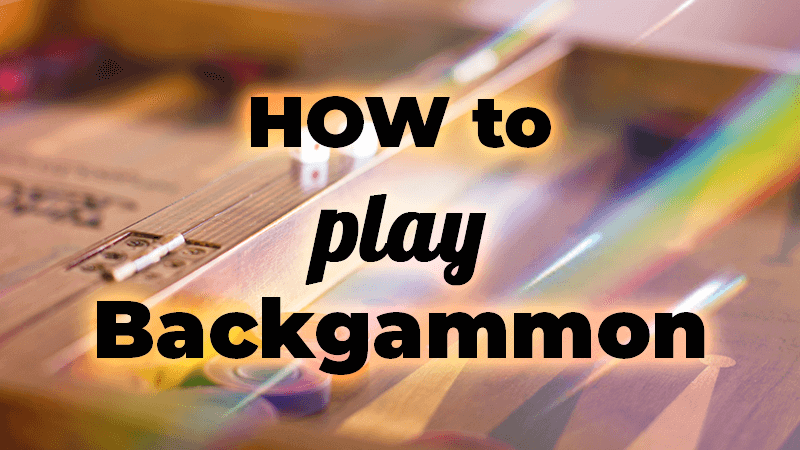
You can check our quick introduction on how to play or read the detailed article below.
What do you need for a game of Backgammon
A standard set includes:
- A gameboard divided into 4 boards, each field consisting of 6 two-colored triangles called ‘points’.
- 15 black and 15 white checkers.
- A standard pair of dice.
Initial arrangement of checkers in Backgammon
We can number the points from 1 to 24, where 24 is the outermost one and 1 is the innermost.
- 2 checkers are placed on position 24
- 5 checkers are placed on position 13
- 3 checkers are placed on position 8
- 5 checkers are placed on position 6
Your opponent’s checkers are placed opposing yours like a mirror.
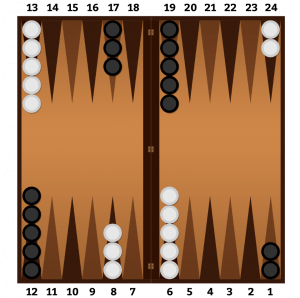
Who starts first
Before the first game, each player rolls a single dice. The one that rolls higher starts first.
If there are multiple games in a match, the winner from the past game rolls first.
Movement of checkers
You can move your checkers only in one direction. It is always from position 24 to position 1. Your opponent moves his checkers in a reverse direction.
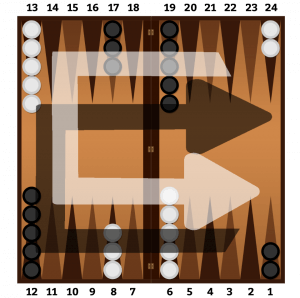
The number of the rolled dice indicates how many positions, or pips, you can move your checkers with. The following rules apply:
- A checker can be moved only to an open position. A position is declared open when there aren’t 2 or more opponent’s checkers on it.
- The number of the dice represents two separate movements. If a player rolls 6 and 3, he can move 2 checkers with 6 and 3 pips, or he can move 1 checker with 9 pips (if at least one of the two intermediate positions are opened)
- If a player rolls a double, he must play it two times. For example, if you roll 5 and 5, you must play four 5’s.
- If a player has 1 or more checkers that are hit, he must return them on the board first before he can move any other checkers.
- A player must play all his pips from the rolled dice if it is legally possible. If he is blocked to play both, he must play the bigger number if possible.
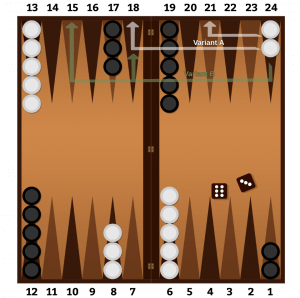
Hitting an opponent’s checker
If your opponent has a single checker on a position it is called a ‘blot’. You can hit a blot by placing your checker on its position. In the example below the black player’s checkers on position 2 and 4 are ‘blots’. White player’s checkers on position 6 and 8 can hit them.
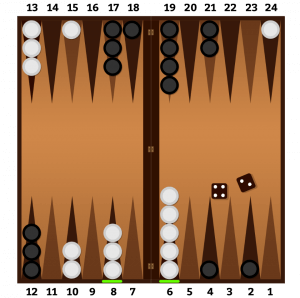
Entering a checker from the bar
When a checker is hit, it is taken away from the board and put on the bar. A player with a checker on the bar must first enter it back on the board before he can move his other checkers. This happens when he rolls a number that corresponds to an empty position in the enemy’s home board. In the example below, the black player must enter his checker in one of the empty positions from 1 to 6. With dices 6 and 3, only position 3 is empty, so the player is obliged to place it there. If there are no empty positions to place his checkers, the player skips his turn.
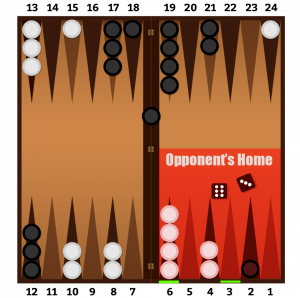
Bearing off your checkers
When a player moves all his 15 checkers into his home board, he can start bearing them off the board. The following rules apply:
- The player can bear off a checker only from a position that’s equal to the number of the dice.
- If there is no checker on a position where you can bear it off, you must move a checker from a higher position. If there are no checkers on a higher position, then you can bear of your checker on the highest position, as long as it is lower than the rolled dice.
- If there is an alternative move, the player IS NOT obliged to bear off a checker.
- Once a checker is born off, it can not return to the board.
Doubling
A standard game of backgammon brings 1 point to the victor. During the course of the game, both players can use the doubling cube and double the points. When a player uses the cube, it moves to the opponent’s side of the board and he gains control of it. If the opponent uses the cube again, the control shifts back to the first player, and so on.
Winning at Backgammon
The player who manages to bear off all his checkers first, wins. A standard victory brings points, equal to the number of the doubling cube.
If the losing player hasn’t borne off any checkers, the winner wins a ‘gammon’ and gets points equal to two times the doubling cube.
If the losing player hasn’t borne off any checkers, and still has checkers on the bar or in the opponent’s home, the winner wins a ‘backgammon’ and gets points equal to three times the doubling cube.
Common Questions People Ask
What is the ace-point?
The ace-point, or one-point, is the last point on the board the player can move his checkers to, before he has to bear them off. Your two farthest checkers are initially placed on the opponent’s ace-point.
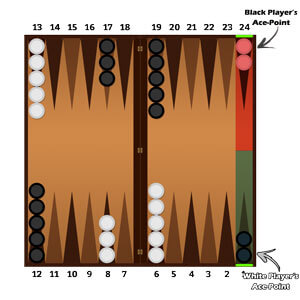
Can I skip my turn?
No, you can not skip a turn if there is a legal move. Furthermore, you have to play the maximum possible moves. If, for example, you roll ⚂⚄ and there are two checkers that can move with 3 positions, but only one of them can move afterward with another 5 positions, while the other is blocked, you are obliged to move the first checker.
Am I allowed to hit-and-run?
Hitting and running is allowed in Backgammon. If there is a bolt (a single opponent’s checker) you can hit it and then move your hitter again.
If I roll doubles, do I roll again?
No, there is no second rolling on doubles. You do get to play 4 moves, but you do not get to roll the dice again.
How many checkers can I stack on a single position?
There is no limit on how many checkers you can stack on a single position. Since you play with 15 checkers, 15 is the maximum possible amount of checkers that can occupy a single position on the board.
